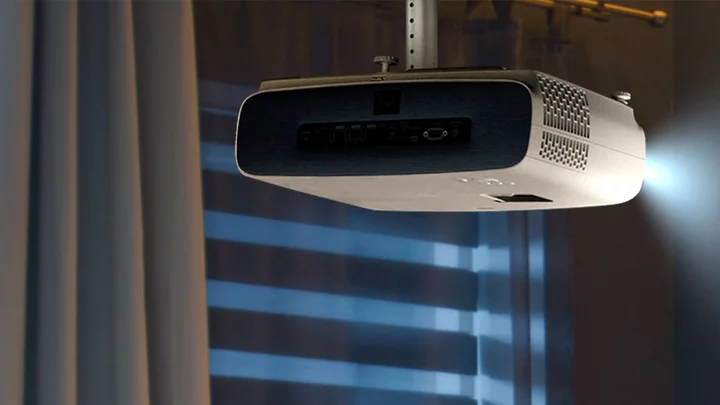The BenQ HT3560 is a near doppelganger to the BenQ TK860i we recently reviewed. The difference? As a home entertainment projector, the TK860i is designed to stand up to ambient light, even at the expense of compromising on image quality. The HT3560 is meant for traditional home theaters, meaning dark rooms, which shows in its lower brightness but better color accuracy compared with its close cousin. It also comes without the TK860i's streaming dongle or its extra HDMI port, which helps make its list price a touch lower, at $1,699. It's impressive enough to be our latest Editors' Choice pick for a lamp-based home theater projector.
Lens Shift Makes Setup Easy
Like most 4K home projectors, the HT3560 puts 3,840 by 2,160 pixels on screen courtesy of a 1,920-by-1,080-pixel DLP chip that uses TI's fast-switch pixel shifting. As with the TK860i, it pairs the chip with a lamp, but unlike its close cousin, it uses a six-panel color wheel with two red segments, two greens, and two blues. That's instead of a four-panel wheel with red, green, blue, and white segments. The lack of a white panel translates to lower brightness but better color accuracy, and is arguably the most important design difference between the two projectors.
The 9.25-pound weight and 4.9-by-15.9-by-10.4-inch size make the HT3560 most appropriate for permanent installation on a flat surface or in a ceiling mount. Setup is mostly standard, with manual focus and a 1.3x zoom. However, a small vertical lens shift is a convenient extra, letting you adjust image position by plus or minus 5% of the image height up or down. In many cases—particularly with a ceiling mount that's just a bit off its best position, this can let you avoid having to tilt the projector and then square off the image with a digital keystone adjustment, which would lower brightness and can introduce artifacts. The three HDMI 2.0b ports on the back panel are another nice touch, letting you connect an external audio system to the port that supports eARC and still have two connectors free for video sources, such as a streaming dongle you may already own.
(Credit: BenQ)Many home theater projectors offer minimal speaker systems or lack them altogether, on the grounds that if you're serious about home theater you'll want a better sound system than can fit in a projector case. However, the HT3560 offers an onboard set of dual 5-watt chamber speakers, which in our tests delivered surprisingly high quality combined with enough volume to fill a large family room. If you want to use an external sound system, however, you can connect it to the 3.5mm or S/PDIF audio-out ports, or to the HDMI port with eARC support as mentioned above.
Testing the BenQ HT3560: Impressive Image Quality
The HT3560's menus offer four predefined picture modes for SDR input, plus a User mode and ISF Day and Night modes (intended for those who want to pay for a professional ISF calibration). As with many projectors, the brightest mode, Bright, has an obvious green bias, making it best avoided, with the possible exception of occasional use on a bright day in a room with windows. All of the other three deliver good enough color accuracy by most people's standards. Straight out of the box, Cinema and Filmmaker modes are the two best on that score.
BenQ says the color gamut offers 100% coverage of Rec.709 (the standard for HDTV) and 95% coverage of DCI-P3 (the film industry standard), and each projector comes with its own test results showing how well it scored on gamut and accuracy after factory calibration. However, keep in mind that even with no changes in settings, any projector can deliver different results on these tests when using a different screen in a different room.
(Credit: BenQ)Between the two modes with best color accuracy, Filmmaker did a slightly better job in my tests retaining the subtle shading that gives rounded objects a three-dimensional look. Neither handled dark scenes well with default settings. But when I turned on the Local Contrast Enhancement feature, both improved dramatically. Between them, Cinema mode did the better job on contrast and shadow detail, making it my top pick for the viewing tests. Note that the menus offer an extensive list of other options you might want to adjust as well. For example, the Dynamic Iris, which automatically adjusts image brightness depending on the image content in any given frame, is on by default in some modes and set to High. In some scenes, that translated to adjusting brightness in multiple discrete steps as well flickering. Dropping the setting to a lower level solved the problem.
For HDR, the HT3560 supports HDR10, HDR10+, and HLG. For HDR10 material, the mode choices were HDR10 and Filmmaker, with HDR10 the default and also what I chose for the viewing tests. For other HDR material, the mode was locked in to HDR10+ or HLG, as appropriate.
(Credit: BenQ)For viewing movies and video in a dark room, the HT3560 delivered top-tier image quality for the price, with good color accuracy, saturation, contrast, and sense of three-dimensionality, as well as appropriate dynamic range for the mode. Even the most challenging dark scenes in our test suite kept virtually all of the shadow detail and dramatic visual impact they're meant to show, whether the material was 1080p SDR or 4K HDR.
For full HD 3D, the HT3560 supports DLP-Link glasses using a single 3D mode. The image showed a slight yellow bias in my tests, but I didn't see any crosstalk, and 3D-related motion artifacts were at the low end of the range typical of today's projectors.
(Credit: BenQ)Rainbow artifacts—the red/green/blue flashes that any single-chip DLP projector can show—may be a problem for those who see them easily, as I do. They showed up more frequently in my tests than is typical, but were fleeting enough that if you don't see them as easily, you may not see them at all. As always with single-chip projectors, be sure to buy from a dealer who allows easy returns without a restocking fee, so you can test it out for yourself.
Most gamers will appreciate the HT3560's lag times, which aren't state-of-the-art short, but short enough for all but the most serious gaming. I timed them with a Bodnar meter at 18 milliseconds (ms) for both 4K and 1080p at 60Hz, 21.3ms at 120Hz, and 8.9ms at 240Hz.
(Credit: BenQ)Although the HT3560 is meant for viewing in dark rooms, where its good contrast will show off, it's bright enough to be usable in a family room with lights on as well. Using the Society of Motion Picture and Television Engineers (SMPTE) recommendations, the rated 2,200 lumens is enough to light up a 215-inch-diagonal, 1.0-gain, 16:9 screen in a dark room. In my tests, it easily filled my 90-inch, 1.0-gain screen using the lower brightness Cinema setting for SDR, and the appropriate modes for HDR input. The same modes were also easily bright enough for comfortable viewing using an 80-inch screen on a bright day in a family room with lots of windows.
Verdict: A Top-Tier 4K Home Theater Projector
For those who are lucky enough not to be sensitive to red/green/blue flashes or don't mind seeing them, the BenQ HT3560 is a solid-enough pick to make it our newest Editors' Choice honoree for a low-to-moderately priced 4K home theater projector.
That said, you should also consider the slightly more expensive Epson Pro Cinema 4050, our current top pick for a moderately priced 4K home theater model, the essentially identical Epson Home Cinema 4010, or the significantly more expensive Epson Pro Cinema LS12000. The resolution for the first two Epson models isn't actually 4K, but from normal seating distance at screen sizes typical for a home theater, they both show more detail than many 4K models do. The LS12000 puts a 4K image on the screen, and the difference shows. All are three-chip LCD projectors, which means they aren't prone to rainbow artifacts, and all have much more extensive zoom and lens shift than the HT3560 does, for far more flexible installation and better handling of movies with different aspect ratios. The LS12000 also offers a laser light source.
Compared with these options, the BenQ HT3560's big advantage is its low price, with no reason to pay more if rainbow artifacts aren't an issue for you and you don't need the more sophisticated lens control.









